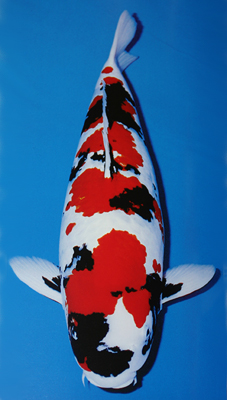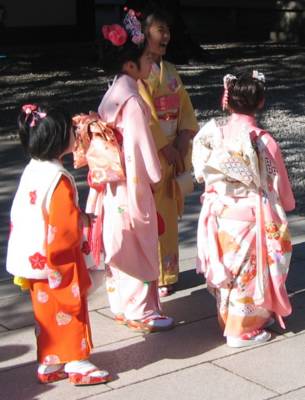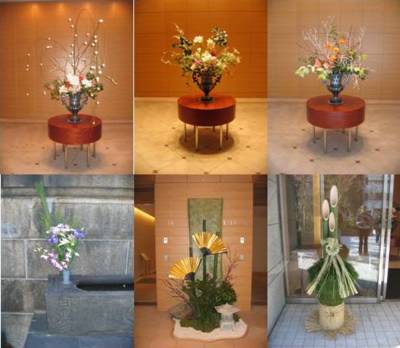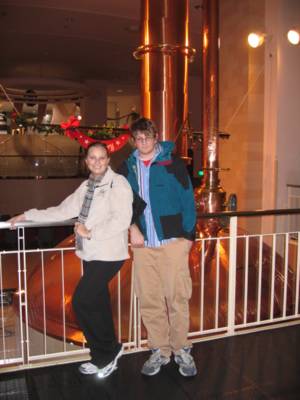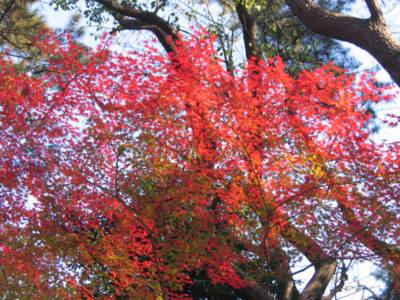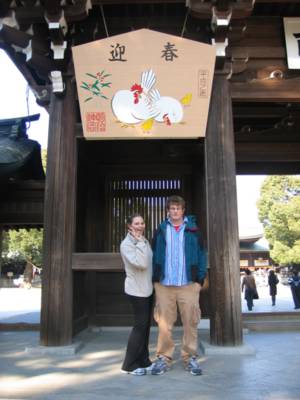Today I went to a koi show here in Tokyo. My pictures don't do the fish justice - but catch the picture of the champion for an idea of what they really look like. This is a great way to view the very best fish up close but not necessarily the best way to enjoy them. The blue plastic pools in a convention hall with fluorescent lighting just isn't that aesthetic! Much nicer to see them in a pond in a park setting.
There were all types and sizes from a few inches up to over a yard. There were hundreds of fish there. This is just a few of the types. There are also black and white ones, yellow ones, metallic ones, all types. Hey - since you are here, why not vote on the best fish. Just make a comment under your favorite one. I liked the Taisho Sanke and it was one of the first fish I saw when I walked in.
Want to know more about koi? Try this link: Koi Encyclopedia
So, this has been a very good weekend for fish - first Tsukiji and then the koi show. Hope you enjoyed yours...
V=612
Sunday, January 23, 2005
Friday, January 21, 2005
Tsukiji - Roy Searches for the Freshest Tako
Tsukiji is the big fish market in Tokyo. All kinds of edible things from the sea. Definitely worth a visit if you can get there. There are incredible numbers of species and cuts of fish. The big auction starts early - about 3:00 in the morning. And the activity is amazing. Here, Roy sorts threw the Octopus (Tako) for his dinner.
By the way, check out the new clock in the sidebar on my blog. Pull down the menu with your mouse and you can find the time in a number of interesting places where I hang out. Thanks to Erica http://www.swantrek.com/ for finding it and all the help in getting it to work the way I wanted.
V=575
By the way, check out the new clock in the sidebar on my blog. Pull down the menu with your mouse and you can find the time in a number of interesting places where I hang out. Thanks to Erica http://www.swantrek.com/ for finding it and all the help in getting it to work the way I wanted.
V=575
Sunday, January 16, 2005
You have to eat
This has been a very slow weekend. Saturday the email was down at work so there wasn't too much catching up to do. I was only there about 4 hours. Today I took the whole day off and did nothing except my laundry. And tomorrow is "Chiyoda Founding Day" so I have the day off. Normally I would go in anyway but I have decided to not go in.
I can't really remember the last time I took two plus days off when I didn't have a visitor. It seems almost sinfully decadent. Accordingly, there isn't much to write about so I'll turn back to that old standby - food.
One of the things I get asked about fairly often, especially from Japanese people, is what do I eat when in Japan. And people want to know if I cook. Here is what I typically do:
Breakfast: Eat cereal, fruit, salad, and coffee in the restaurant upstairs in the building. It is free with the rent.
Lunch: Eat at a restaurant in Tsurumi on most weekdays. Sometimes I go to the 7-11 and get a sandwich and bring it back to work. If it is Sunday I will stop wherever I am when I get hungry and eat at a restaurant.
Dinner: Eat at a restaurant about half the time and fix something at the apartment half the time.
I have written about restaurants, so here is what I do when I "cook".
I can't really remember the last time I took two plus days off when I didn't have a visitor. It seems almost sinfully decadent. Accordingly, there isn't much to write about so I'll turn back to that old standby - food.
One of the things I get asked about fairly often, especially from Japanese people, is what do I eat when in Japan. And people want to know if I cook. Here is what I typically do:
Breakfast: Eat cereal, fruit, salad, and coffee in the restaurant upstairs in the building. It is free with the rent.
Lunch: Eat at a restaurant in Tsurumi on most weekdays. Sometimes I go to the 7-11 and get a sandwich and bring it back to work. If it is Sunday I will stop wherever I am when I get hungry and eat at a restaurant.
Dinner: Eat at a restaurant about half the time and fix something at the apartment half the time.
I have written about restaurants, so here is what I do when I "cook".
- sandwich from the 7-11
- instant noodles (my favorite is "GooTa")
- salad (you can buy them pre-made at the 7-11)
- Japanese pickles (oshinko)
- yogurt (my favorite is Aloe Vera)
- rice crackers (my favorite is kuro mame sembei - black bean crackers)
- tempura (buy it at the store and heat it up)
- boiled eggs (tamago)
- soy bean fritos
- bananas (the best fruit ever)

Wednesday, January 12, 2005
Japanese Kagamiwari Celebration
Tonight we celebrated the start of our project with a Kagamiwari - the breaking of the barrel or cask of sake. There were speeches and then the barrel was broken and then everyone drank sake. Afterwards, lots of food. There were about 150 people in attendance. I am the snappy dressed guy in the dark suit with the blue ceremonial jacket holding a wooden mallet in case you are looking for me.
I got to give the "Kanpai" afterwards. This site has the story of the ceremony: kagamiwari
I got to give the "Kanpai" afterwards. This site has the story of the ceremony: kagamiwari
Painting the eye on Daruma-san

A traditional thing to do at the start of the New Year, or sometimes of a project, is to set a goal and then paint in one eye on a Daruma doll. If the goal is obtained you paint in the other eye. Here Ikeda-san paints in the eye of Daruma with the goal of a successful project for us following the kagamiwari.
Daruma was an Indian monk who established Zen Buddhism. According to legend, he meditated so long he lost the use of his arms and legs. Once during meditation he lost concentration and fell asleep. He was so angry he cut off his eyelids and when they fell to the ground they are said to have sprouted China's first green tea plants. Only later did Zen arrive in Japan. Here is a site if you would like to read more about him: Daruma
Monday, January 10, 2005
Seijin-no-hi (Coming of Age Day)
Coming of age day is the second Monday of January (used to be the 15th of January). It is held for those who turn 20 and celebrates their transition to adulthood - which means you can drink, smoke, and vote. Traditionally it means dressing up and going to hear a speech from the local officials. The traditional dress for women is a kimono. There are a number of good web sites on the internet about the kimono, but here is one you might find interesting: http://www.japanesekimono.com/
I saw a number of young women wearing kimono today but thought this one looked especially nice. She was with her mother at the Meiji Shrine and a lot of people were stopping her and asking for a picture (the whole point of going to Meiji Shrine and wearing your kimono).
I saw a number of young women wearing kimono today but thought this one looked especially nice. She was with her mother at the Meiji Shrine and a lot of people were stopping her and asking for a picture (the whole point of going to Meiji Shrine and wearing your kimono).
Sunday, January 09, 2005
Can't I take a bath in peace?
I think I've written about this before, although maybe not on the blog, about women in the restrooms here. It happens from time to time that the woman who cleans the restrooms will come in as you are standing there and it really isn't a big deal. I've seen it at the airport, train stations, and work. Of course the first time it happened I thought I'd walked into the Ladies Room.
And then there was the woman attendent at the onsen at the golf course where you take off your clothes to take a bath. So I had gotten pretty used to that. After all, I believe you should be prepared to live as a Roman when in Rome.
But today they came to clean my room and rang the doorbell, but I was in the shower. I am usually not here and they have a key. I yelled but they apparently didn't hear me and just came on in. When they heard the shower they closed the door to the bathroom and went to work.
So, I finished my shower and shaved. Then I wrapped a towel around me and walked into the bedroom. A man and a woman were there changing the bed. My jeans were draped on the back of the chair. I walked into the closet to change. The man said "Suimasen", picked up my blue jeans, handed them to me, and closed the closet door behind me.
Now, that's good house cleaning service. Unfortunately, this seems limited to the women in the cleaning staff. And no, there are not any men in the ladies room. And the ladies I've seen so far look like they just left the church bazaar and are not one of those stylish Tokyo women you see on the train or on the street. It is just one of those things that make life a little different here.
Besides, I am lucky enough to have someone who cleans my room.
And then there was the woman attendent at the onsen at the golf course where you take off your clothes to take a bath. So I had gotten pretty used to that. After all, I believe you should be prepared to live as a Roman when in Rome.
But today they came to clean my room and rang the doorbell, but I was in the shower. I am usually not here and they have a key. I yelled but they apparently didn't hear me and just came on in. When they heard the shower they closed the door to the bathroom and went to work.
So, I finished my shower and shaved. Then I wrapped a towel around me and walked into the bedroom. A man and a woman were there changing the bed. My jeans were draped on the back of the chair. I walked into the closet to change. The man said "Suimasen", picked up my blue jeans, handed them to me, and closed the closet door behind me.
Now, that's good house cleaning service. Unfortunately, this seems limited to the women in the cleaning staff. And no, there are not any men in the ladies room. And the ladies I've seen so far look like they just left the church bazaar and are not one of those stylish Tokyo women you see on the train or on the street. It is just one of those things that make life a little different here.
Besides, I am lucky enough to have someone who cleans my room.
Old and New Tokyo
Hey! Wasn't that building in "Lost in Translation"? Yes it was. Everyone I know from the United States tells me so but none of my Japanese friends have mentioned it. This is New Japan. Just behind it and to the right is Tokyo Tower which was built in 1958 and is 13 meters taller than the Eiffel Tower it was modelled on. It is a symbol of the rebirth of Japan after World War II.
Sunday, January 02, 2005
Atagoyama Flowers for the Holidays
Starting at the lower left and going clockwise:
- Flowers left as an offering at the temple next to my apartment
- A holiday arrangement in the lobby - I've seen the "Christmas balls" on the branches in other arrangements also - in the old days these were rice cakes left to dry on branches and then eaten during new years
- A typical arrangement for my apartment building
- The white branches in this arrangement show up in the winter
- Let's call this a Japanese christmas tree. There are three bamboo pieces cut at an angle at the top surrounded by evergreens which are tied in place with rice straw. Hatta-san says it is a traditional decoration for the entrance of a building or house.
- Another traditional arrangement, this time inside the building.
Atago Jinja
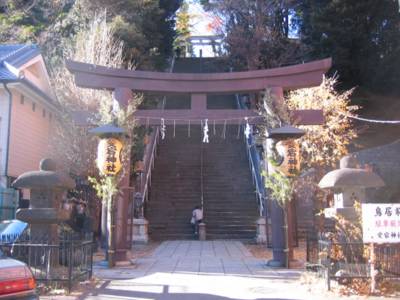
Atago Jinja is my neighborhood shrine and is located on the North side of my apartment building. There were a good number of people there today but it was relatively quiet compared to some of the other better known shrines and temples.
Atago Jinja was built by the first Edo era shogun, Tokugawa Ieyasu, in 1603. It is built on Atagoyama (Atago hill) which is the highest location in Tokyo's 23 wards. The steep steps are said to be a symbol for success in life and it is considered good luck to climb them. They are also famous for a young samurai who rode his horse up them to deliver a plum gift to his lord.
May you be successful in 2005...
The Day after New Years at Asakusa Senso-ji
Senso-ji, also known as Kannon-sama, is probably the most famous temple in the Tokyo area and has been on this location since the 7th century. It is famous for the huge paper lantern in the gate . Note the fierce guardian deities on each side.
Senso-ji is always crowded but today it was literally packed. All the streets were closed off and there was a huge line to get into the temple. There were stalls and all the shops were doing a great business.
Senso-ji is always crowded but today it was literally packed. All the streets were closed off and there was a huge line to get into the temple. There were stalls and all the shops were doing a great business.
Saturday, January 01, 2005
New Year's Day at Tokyo Tower
I have always liked studying time, clocks, and calendars. One of the things I am always being asked is "what time is it in Japan?". Here is a web site that will give you the time anywhere in the world: http://www.timeanddate.com/. I am posting this site on the right side of my blog so it should be easy to find again if you need it. It is easy to use and will also tell you how to dial any location in the world on the telephone. That is another thing I am always asked about. By the way, I put my telephone number at the bottom of all my emails so just look at an old one if you are trying to find it.
Of course one of the most important dates on any calendar is the first day of the year. Above you can see Tokyo Tower on 1/1/2005. The New Year is a very important holiday in Japan and it is considered a day to start anew as it is in many places. Just before midnight, they ring the temple bell 54 times - the same as the number of sins in the Buddhist religion. Then just after midnight they ring it 54 more times. I suppose this rings out the old ones and drives new ones away.
I think I've written before that odd numbers are considered lucky here and festivals fall around them. So:
Time marches on. Happy 2005!
Of course one of the most important dates on any calendar is the first day of the year. Above you can see Tokyo Tower on 1/1/2005. The New Year is a very important holiday in Japan and it is considered a day to start anew as it is in many places. Just before midnight, they ring the temple bell 54 times - the same as the number of sins in the Buddhist religion. Then just after midnight they ring it 54 more times. I suppose this rings out the old ones and drives new ones away.
I think I've written before that odd numbers are considered lucky here and festivals fall around them. So:
- 1/1 January 1st - New Years Day
- 3/3 March 3rd - Hina Matsuri, the doll festival and a day for girls
- 5/5 May 5th - Hamamatsu Matsuri, Kite Flying Festival and a day for boys
- 7/7 July 7th - Tanabata Matsuri, Star Festival
- 9/9 September 9th - According to Hatta-san this one has something to do with the emperor
Time marches on. Happy 2005!
New Year's Festival at Meguro-Fudosan Ji
Last night I went to my friend Hatta-san's house for a New Year's Party. He had his own family, two families that were friends from college, another friend from work and his family, plus me. It was very nice. We had lots of food, including sashimi, sushi, yakitori, and meat. Just before midnight we ate cold soba noodles which is the traditional thing to do.
There was beer, sake, and champagne at midnight. After a year, I am starting to develop definite tastes about sake. I think the best is dry (karakuchi no sake) served cold (reishu). Ginjo is a region that makes good sake and is worth asking for.
On TV, they had various entertainment, just like the United States, and a countdown to midnight. It is very customary to go to the temple on New Years and they showed a number of them from all over Japan. There was entertainment and a large crowd at Zojo-ji which is the large temple down from my apartment.
We went to the temple close to Hatta-san's house and you can see the festival in the picture above. Hatta-san said the crowd was down from what it usually is due to the cold weather. The were serving ame-sake (sweet sake served hot) to keep the chill down. I bought a special arrow which is supposed to keep evil away.
When I got to the apartment, the fire alarm went off. At least I know the alarm system works well. We had to evacuate and I didn't get to bed until 3:00 am. It turned out to be dripping snow somehow set off the alarm. Oh well, at least I didn't have to go to work today.
There was beer, sake, and champagne at midnight. After a year, I am starting to develop definite tastes about sake. I think the best is dry (karakuchi no sake) served cold (reishu). Ginjo is a region that makes good sake and is worth asking for.
On TV, they had various entertainment, just like the United States, and a countdown to midnight. It is very customary to go to the temple on New Years and they showed a number of them from all over Japan. There was entertainment and a large crowd at Zojo-ji which is the large temple down from my apartment.
We went to the temple close to Hatta-san's house and you can see the festival in the picture above. Hatta-san said the crowd was down from what it usually is due to the cold weather. The were serving ame-sake (sweet sake served hot) to keep the chill down. I bought a special arrow which is supposed to keep evil away.
When I got to the apartment, the fire alarm went off. At least I know the alarm system works well. We had to evacuate and I didn't get to bed until 3:00 am. It turned out to be dripping snow somehow set off the alarm. Oh well, at least I didn't have to go to work today.
Thursday, December 30, 2004
It's Snowing on New Year's Eve in Tokyo

Well, the family is gone and they made it home safely. The weather was great while they were here but it has turned colder since. The view here is from my balcony down onto the temple gate below.
I went into work onthe 29th and 30th. The 29th is the "official" last day of work and then there is the week long New Year's holiday which is one of most looked forward to in Japan. On the last day, Chiyoda holds an office party.
Everyone has a drink and there are snacks. Afterwards, it seems to be tradition to go to a karaoke bar at Chiyoda. I went and we had a good time. Since I had not had quite as much to drink as some of the others it was a little bit hard to get me to sing but I finally relented. For those who must know, I sang Hank Williams "Jambalaya" and the old blues song "Stormy Monday". These songs are simple, don't have any vocal range, and nobody there knew if I was singing it right anyway.
My friends from work were a little more lively. They sang Western and Japanese songs in about equal number and I was surprised at how good some of them were. The girls usually danced while they sang and if they did duets they were pretty much dancing in unison - it must have been memorized from the video. Anyway, it was good fun.
Today I have been doing the housework and just relaxing.
Akemashite omedeto gozaimasu - Have a happy New Year!
Saturday, December 25, 2004
A Japanese Maple at the University of Tokyo
It has been a very warm year in Japan and this maple is just turning colors. Tokyo University is well known and has a kind of European look to it. It is located near Ueno on the North side of the city. They sell beer in the University student center just like at Baylor and we were fortunate enough to find T-shirts - thank goodness...
The Year of the Rooster
Friday, December 24, 2004
Theater in Kyoto
Kyoto is of course known for its cultural arts, crafts, and food. It is the cultural center of Japan and you can still see many things that have been unchanged for centuries. (hint to one member of the family for the future: Indian food is not considered a traditional Kyoto specialty)
Dave and the Shinkansen
This is the shinkansen (bullet train) that we took back from Kyoto. The train has a top speed of close to 300 km/hr (180 mph) yet is very smooth and very quiet. The seats are spacious and it is very efficient. But tickets are a little bit pricey. The train was full the Saturday that we went to Kyoto.
Pagoda in Kyoto
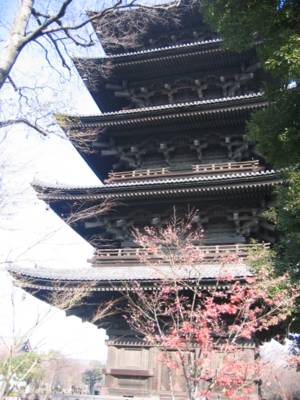
We had a very nice trip to Kyoto and of course visited a number of temples and went shopping. This was my first time to Kyoto and it wasn't quite like I expected. Kyoto is an interesting mix of old and new Japan but appears more European to me in some respects. The river through the city, the greater space than Tokyo, and the avenues make it seem so.
Friday, December 17, 2004
Meg Graduates from Baylor!
Here she is, by the statue, a full fledged graduate with a job and everything. Lots of family and friends were there and we had a great time. When Megan started at Baylor I told her I expected to be back in four years to take her picture at the statue. She made it in three and a half! Congratulationas Megan....
Subscribe to:
Posts (Atom)
